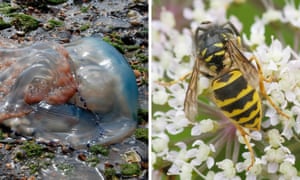Jellyfish flourish but wasps wobble in year of climate confusion
It was a good year for picnickers, but a bad one for sea swimmers: in the National Trust’s annual survey of how the weather and climate has affected Britain’s flora and fauna, jellyfish were judged to have flourished while wasps suffered a sharp decline.
A sunny winter was followed by a late spring, which meant summer
migrant birds were late, as were the leaves on the hedges. A pretty wet
and windy summer followed, but September and October came good, leading
to prolonged flowering for many summer plants and a longer season for
insects.
As so often in recent winters, violent storms – including Storm Desmond
at the beginning of December – wreaked havoc on human infrastructure,
but it is too early to assess the possible long-term damage to plants
and wildlife.
Matthew Oates, a National Trust nature and wildlife specialist, said
he was most struck by the proliferation of jellyfish and the paucity of
wasps. “We’ve seen unprecedented jellyfish invasions,” he said. “This
may be due to overfishing and warming seas, which has led to huge
plankton booms and reduced the number of predators.”
Some believe the idea of a jellyfish invasion is a media-driven “silly season” story. At the height of summer, naturalist Steve Backshall argued in the Guardian
that it was not uncommon for “smacks” or “blooms” of jellyfish to
become stranded on British shores. He also pointed out that the barrel
jellyfish that appeared this summer only had a mild nettle-like sting. More disturbingly, there was hardly a wasp to be seen this summer. “Wasps had another poor year, particularly in the south-west,” Oates said. “This represents a wider decline in our insect populations, thought to be a result of confounding weather alongside the possible effects of pesticides used in farming.
“We need to ask what’s happening to our wasps. Many might welcome their dwindling numbers, but the ecological world is a delicate one, and with our two species of common wasps incredibly scarce in many districts for the second consecutive year, we have to ask what impact this is having.”
The survey made a number of cheerful discoveries, including the appearance of the red-shanked carder bee at Birling Gap in Sussex, which is now part of a conservation management plan. The long-tailed blue butterfly, an extremely rare migrant, returned to the south-east, breeding again on the white cliffs of Dover.
The good news
- Conservation projects in places such as Malham Tarn and Upper Wharfedale in North Yorkshire helped the barn owl population flourish.
- There were spectacular appearances of barrel jellyfish, particularly around the south-west of England and Wales. As climate change causes sea temperatures to rise and plankton blooms become bigger and last longer, there are likely to be more jellyfish appearing even further north.
- A lack of stormy weather or frosts in early autumn ensured it was a fantastic year for autumn tints and produced a superb apple crop.
- The elegant seabird the little tern enjoyed its best year on Blakeney Point in Norfolk since 2011.
- There was another record-breaking year for breeding guillemots on the Farne Islands off Northumberland.
- BBC Springwatch enthusiasts noted a huge increase in goldfinches in gardens.
The not so good news
- Atlantic puffins were added for the first time to the International Union for Conservation of Nature (IUCN) red list of species at risk of extinction.
- Frogs and toads in the south of England faced a difficult year as many pools dried up over the spring.
- It was a disappointing autumn to see fungi after a cool, wet summer was followed by a dry autumn.
- As well as being a worrying year for wasps, there was a noticeable shortage of ladybirds.










No comments:
Post a Comment